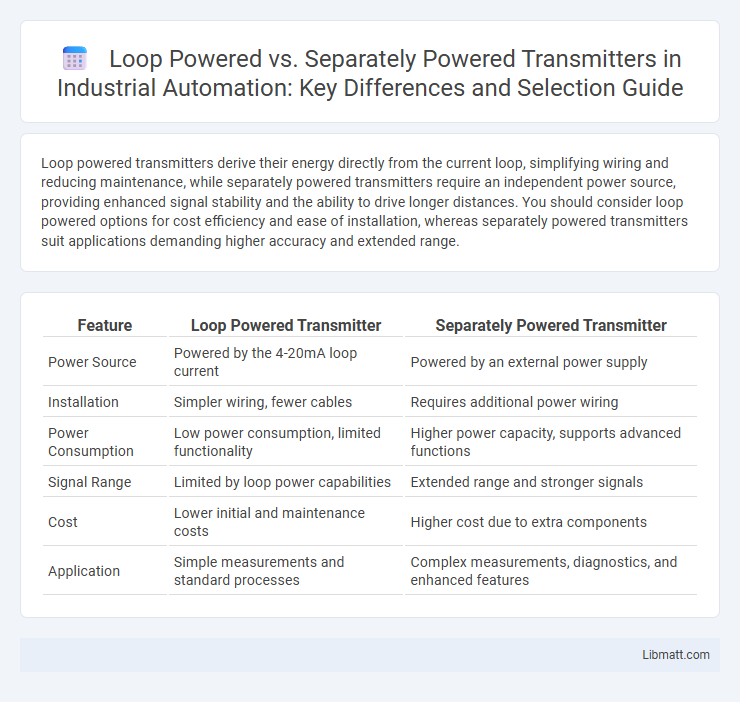Loop powered transmitters derive their energy directly from the current loop, simplifying wiring and reducing maintenance, while separately powered transmitters require an independent power source, providing enhanced signal stability and the ability to drive longer distances. You should consider loop powered options for cost efficiency and ease of installation, whereas separately powered transmitters suit applications demanding higher accuracy and extended range.
Table of Comparison
| Feature | Loop Powered Transmitter | Separately Powered Transmitter |
|---|---|---|
| Power Source | Powered by the 4-20mA loop current | Powered by an external power supply |
| Installation | Simpler wiring, fewer cables | Requires additional power wiring |
| Power Consumption | Low power consumption, limited functionality | Higher power capacity, supports advanced functions |
| Signal Range | Limited by loop power capabilities | Extended range and stronger signals |
| Cost | Lower initial and maintenance costs | Higher cost due to extra components |
| Application | Simple measurements and standard processes | Complex measurements, diagnostics, and enhanced features |
Introduction to Transmitter Power Options
Loop powered transmitters draw power directly from the current loop, typically 4-20 mA, eliminating the need for external power supplies and simplifying installation in remote or hazardous environments. Separately powered transmitters require an independent power source, which enables advanced features and higher output signals but may increase wiring complexity and cost. Selecting between loop powered and separately powered transmitters depends on application requirements such as power availability, signal range, and system integration needs.
What is a Loop Powered Transmitter?
A loop powered transmitter derives its operating power directly from the same current loop it monitors, typically a 4-20 mA current loop used in industrial sensors and instrumentation. This design eliminates the need for an external power supply, simplifying installation and reducing wiring costs while ensuring the transmitter remains powered as long as the loop current is active. You benefit from reliable, energy-efficient operation with minimal maintenance in process control environments.
What is a Separately Powered Transmitter?
A separately powered transmitter operates independently from the measurement loop by receiving its power from an external source, ensuring stable voltage supply and enhanced signal accuracy. This configuration reduces susceptibility to voltage drops and allows for longer cable runs compared to loop powered transmitters. It is commonly used in applications requiring high precision, complex signal processing, or where power demands exceed what a loop can provide.
Key Differences Between Loop Powered and Separately Powered Transmitters
Loop powered transmitters derive their operational power directly from the current loop, typically 4-20 mA, enabling simpler wiring and lower installation costs. Separately powered transmitters require an external power supply, offering greater flexibility in signal output and supporting advanced features like digital communication. Your choice depends on the application's power availability, signal requirements, and desired system complexity.
Advantages of Loop Powered Transmitters
Loop powered transmitters offer significant advantages including simplified wiring, as they derive power directly from the current loop, eliminating the need for an external power source. This design enhances reliability and reduces installation costs by minimizing components and potential points of failure. Their inherent energy efficiency and compact size make them ideal for remote or hazardous environments where power availability and space are limited.
Advantages of Separately Powered Transmitters
Separately powered transmitters provide enhanced signal accuracy and stability by isolating the transmitter's power supply from the measurement loop, reducing interference and voltage drops common in loop powered systems. They offer the flexibility to support more complex features, such as advanced diagnostics and longer wiring distances, which are critical in industrial automation and process control. Your system benefits from improved reliability and the capability to maintain accurate data transmission even under fluctuating power conditions.
Typical Applications and Use Cases
Loop powered transmitters are commonly used in simple industrial process control systems where low power consumption and reduced wiring complexity are critical, such as temperature and pressure monitoring in remote or hazardous locations. Separately powered transmitters find typical applications in complex automation environments requiring higher accuracy, faster response times, and additional sensor functionalities, including multi-variable measurement and advanced diagnostics in chemical plants and oil refineries. Both transmitter types play essential roles in ensuring reliable data transmission and process efficiency across various industries.
Installation and Wiring Considerations
Loop powered transmitters require only two wires for both power supply and signal transmission, simplifying installation and reducing wiring complexity. Separately powered transmitters need an independent power source and additional wiring, increasing installation time and potential points of failure. Proper wiring practices for loop powered devices include ensuring correct polarity and minimizing voltage drops to maintain reliable operation.
Factors to Consider When Choosing
Selecting between loop powered and separately powered transmitters depends on factors such as power supply availability, installation complexity, and system reliability requirements. Loop powered transmitters are ideal for simpler setups with limited wiring and centralized power, whereas separately powered transmitters offer higher signal accuracy and support for longer cable runs. Consider environmental conditions, maintenance accessibility, and compatibility with existing instrumentation to ensure optimal transmitter performance.
Conclusion: Selecting the Right Power Option
Selecting the right power option between loop powered and separately powered transmitters depends on application requirements and system design constraints. Loop powered transmitters offer simplicity and reduce wiring by drawing power from the current loop but may limit device functionality due to power constraints. Separately powered transmitters provide enhanced features and improved signal strength by utilizing an independent power source, making them ideal for complex or long-distance measurement systems.
Loop Powered vs Separately Powered Transmitter Infographic

 libmatt.com
libmatt.com